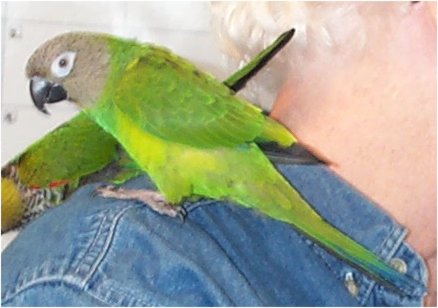Conure - Dusky Headed
Wendell's Conure, Dusky Conure Scientific Name: Aratinga weddellii
Sat, 12th July, 2025 - 5:29 am GMT
Sponsor Ads:

Alternative Name
Wendell's Conure, Dusky Conure Scientific Name: Aratinga weddelliiBasic Info
Mature Dusky Headed Conures are average 11 inches in length. They are mostly green, though their head is grey. The Dusky Headed Conure has a greenish yellow abdomen, while the upper breast is not as bright, being more of an olive color. The feathers are edged in blue. The topside of the tail is blue, while the bottom side is black. Also black are the beaks of the Dusky Headed Conures and their feet are grey. The periphthalmic ring is white, and the iris is yellow, although the young Conures have a dark center coloring. Immatures have a more subdued coloring then the adults. There is a blue variation of this Conure as well as the normal green type.
Health
In captivity, the Dusky Headed Conure will eat a mixture of seeds, oats, rice and millet. Fresh fruits and vegetables, especially carrots, are great additions to the seeds. Table foods can add to their diet as long as you use basic common sense, and do not feed them high fat, sugary or salted foods. Rice, pasta and beans are good examples. Breeding The Dusky Headed Conure, like most parrots, is impossible to sex from sight. A blood test is needed to determine the sex. They can breed anytime, and you will notice that the female is paying close attention to the nest box, which should be around 10x10x18inches. Make sure the hole is big enough, but not too big, usually around 2.5 inches in diameter. They can have many clutches throughout the year, though it is advisable to not let them have more than two or three. They incubate up to five eggs for 23 days. The average clutch size is 3 to 4 eggs. They fledge for about 50 days. Both parents will feed the young.Habitat
They like areas near rivers, marshes and humid forests.Behavior
The Dusky Headed Conure, also known as Wendell's Conure, is not as common in the pet trade as the better known Sun or Nanday Conures, but their popularity is increasing. Despite the fact that they are relatively uncommon in captivity, they are still quite common in the wild. The Dusky Headed Conure is known for its sweet temperament, especially among hand-raised individuals. Though the Dusky Headed Conure is considered average in regards to their noise levels, they mostly make noise when they get excited. Their voices are often described as a sweet chirping sound. As with most birds, they take some time getting used to people, but they eventually adjust. They do like to chew, but that can be taken care of easily with the proper toys. Dusky Headed Conures love to bathe. Misting them on a regular basis is always a good idea and fun to watch. Don't spray them at the end of the day. Instead spray during the day to avoid chills. In the wild, they are social, and are seen in pairs or groups of as little as just a few to a 100 or more. Group size is often dependant on food supplies. Though Dusky Headed Conures are not as brilliant in color as some other parrots, they make up for it with a calmer disposition and less raucous sounds.Origin
ColumbiaHistory
Dusky Headed Conures are from South America. In the wild, they usually only make sound while flying, and are usually quiet while feeding. They like finding dead trees, where they can find insects to feed on and they get their minerals from the soil.Common Foods
insectsSponsor Ads:
The more corrupt the state, the more numerous the laws. -- Tacitus, 56-120 A.D.
Conure - Dusky Headed
Coded by: BGID® | ALL RIGHTS RESERVED Copyright © 2000-2025
Disclaimer | Privacy | Report Errors / Contact | Credits


 President of the United States of America - Real Estate mogul, Pageant owner and now one of the most controversial men in political history.
President of the United States of America - Real Estate mogul, Pageant owner and now one of the most controversial men in political history.  Global warming has been in and out as the "latest" hot topic for many years. It is, according to modern scientists, the result of man-made industrial pollutants, clearing forested areas, agriculture, etc. But now they are thinking it started way before the Industrial Revolution...
Global warming has been in and out as the "latest" hot topic for many years. It is, according to modern scientists, the result of man-made industrial pollutants, clearing forested areas, agriculture, etc. But now they are thinking it started way before the Industrial Revolution...  Politician, US Vice President and President of the USA - Joseph Robinette Biden Jr.
Politician, US Vice President and President of the USA - Joseph Robinette Biden Jr.  versus
versus  Russia: 'The Evil Empire'? Are they all that bad or is it just the USA trying to portray Russia as bad because they are a world power with land bigger and a society very different from the USA ideal?
Russia: 'The Evil Empire'? Are they all that bad or is it just the USA trying to portray Russia as bad because they are a world power with land bigger and a society very different from the USA ideal? 
 Corona virus
Corona virus 
 Users with wide screen monitors can benefit from more content on every page.
Users with wide screen monitors can benefit from more content on every page.